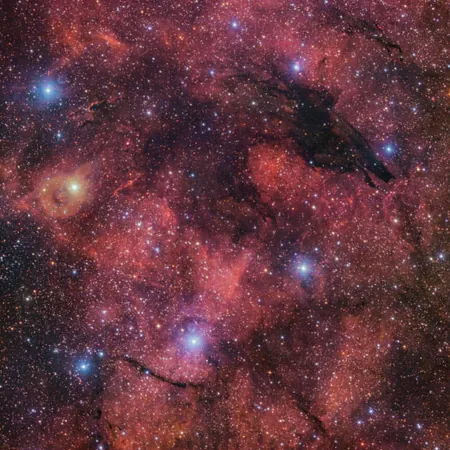
Stunning New Image of the Dark Wolf Nebula Revealed by Astronomers
2024-11-05
Author: Ming
Stunning New Image of the Dark Wolf Nebula Revealed by Astronomers
In a breathtaking new development, astronomers utilizing the VLT Survey Telescope, located at the European Southern Observatory's Paranal Observatory in Chile, have successfully captured an impressive 283-million-pixel image of the enigmatic Dark Wolf Nebula.
Nestled approximately 5,300 light-years away in the constellation of Scorpius, the Dark Wolf Nebula is categorized as a dark nebula—a cold, dense cloud of cosmic dust that effectively obscures the light from stars and other celestial bodies situated behind it. Unlike their more luminous counterparts, dark nebulae do not emit visible light. Instead, they absorb this light but allow radiation at longer wavelengths, making them primarily visible in infrared observations.
“The analysis of these cold clouds is crucial for astrophysics, as they often serve as the birthplaces of new stars,” noted astronomers from the European Southern Observatory in their statement. The newly captured image showcases this fascinating nebula in striking detail, allowing viewers to appreciate the contrasting richness between the Dark Wolf and the surrounding, more luminous star-forming clouds.
Occupying a field of view equivalent to four full Moons, the Dark Wolf Nebula is part of a larger cosmic structure known as Gum 55. Interestingly, some astronomers liken the shape of the nebula to a werewolf lurking in the stars—its ghostly silhouette defined against a backdrop of glowing stellar formation.
The colorful emissions surrounding the nebula are primarily composed of hydrogen gas, glowing vividly in hues of red due to the intense ultraviolet radiation emitted by the newly formed stars embedded within these clouds.
This new image is a part of the broader VST Photometric Hα Survey of the Southern Galactic Plane and Bulge (VPHAS+), an extensive project that has cataloged around 500 million objects within our Milky Way galaxy. Such surveys not only advance our understanding of star formation processes but also enhance our knowledge of the evolution of galaxies over cosmic time.
The unveiling of this stunning image highlights the ongoing endeavors of astronomers and the powerful technology at their disposal, paving the way for further exploration into the mysteries of our universe. What other secrets lie hidden within the depths of space? Only time—and further research—will reveal the answers.



 Brasil (PT)
Brasil (PT)
 Canada (EN)
Canada (EN)
 Chile (ES)
Chile (ES)
 España (ES)
España (ES)
 France (FR)
France (FR)
 Hong Kong (EN)
Hong Kong (EN)
 Italia (IT)
Italia (IT)
 日本 (JA)
日本 (JA)
 Magyarország (HU)
Magyarország (HU)
 Norge (NO)
Norge (NO)
 Polska (PL)
Polska (PL)
 Schweiz (DE)
Schweiz (DE)
 Singapore (EN)
Singapore (EN)
 Sverige (SV)
Sverige (SV)
 Suomi (FI)
Suomi (FI)
 Türkiye (TR)
Türkiye (TR)